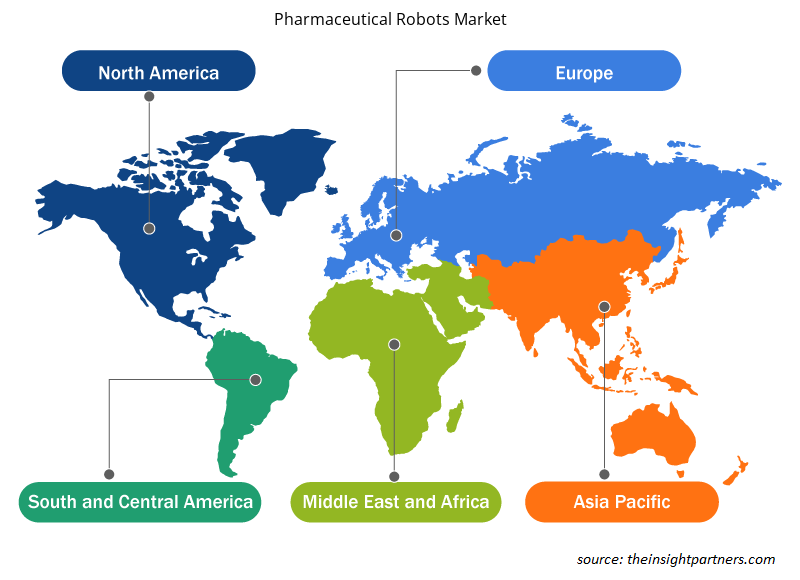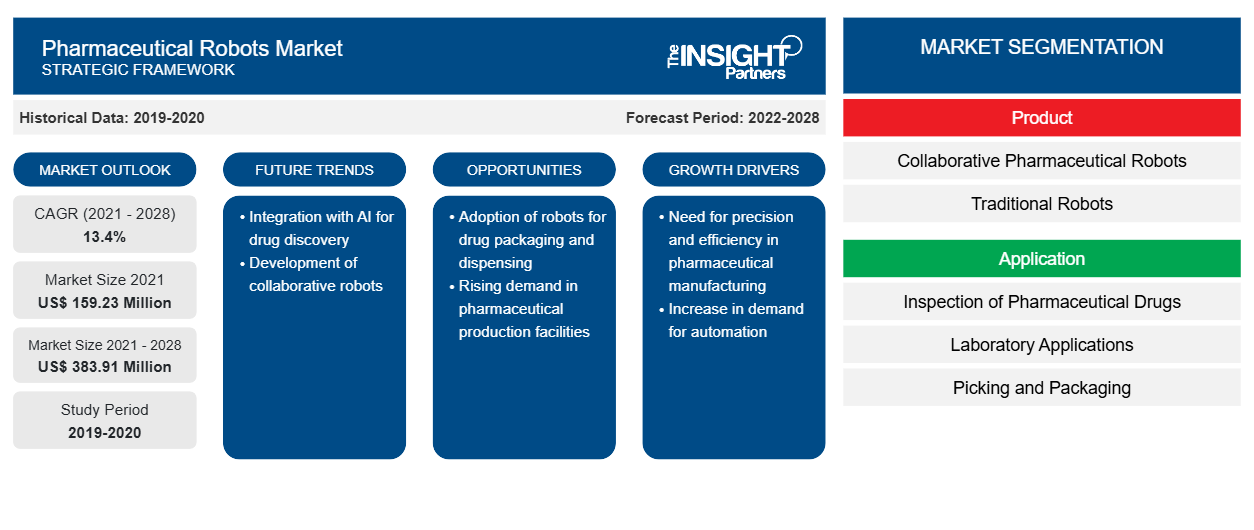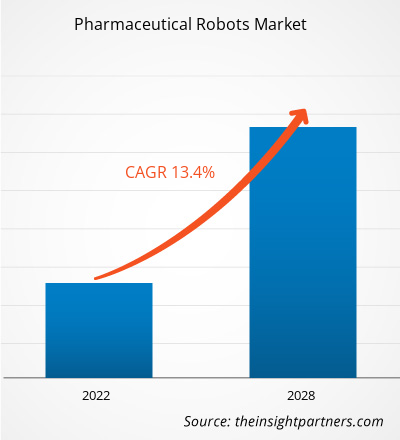[研究报告] 制药机器人市场规模预计将从 2021 年的 1.5923 亿美元增至 2028 年的 3.8391 亿美元;预计 2021 年至 2028 年的复合年增长率为 13.4%。
制药行业要求药品生产高效、精确。因此,在药品制造中使用机器人可以提高质量并降低成本和时间。机器人在灌装、检查、包装、实验室和个性化药品制造方面具有优势。机器人系统是一种自动化系统,具有多个运动轴,可以编程执行任何功能。
该报告提供了对制药机器人市场的见解和深入分析,重点关注各种参数,例如市场趋势、技术进步、市场动态以及全球主要市场参与者的竞争格局分析。它还包括 COVID-19 大流行对所有地区市场的影响。大流行的影响和全球研究活动的减少也损害了制药机器人市场中多家公司的运营和财务执行。世界动物卫生组织 (OIE) 协助研究其正在进行的研究以及 COVID-19 对动物健康和家禽公共卫生的其他影响。该组织还帮助进行风险评估、风险管理和风险沟通。OIE 已部署事件协调系统来协调这些活动。此外,COVID-19 大流行和随之而来的封锁措施对世界各国的畜牧业和家禽业产生了重大影响。随着市场链的开放和地方政府采取额外措施弥补配送系统的瓶颈,供需缺口逐渐缩小。进一步设想,这种影响将持续很长时间,并将对该行业的生计、就业和整体经济产生重大影响。制药机器人市场按剂量、疾病、技术和地区细分。市场按地区细分为北美、欧洲、亚太、中东和非洲以及南美和中美洲。
市场洞察
定制此报告以满足您的需求
您可以免费定制任何报告,包括本报告的部分内容、国家级分析、Excel 数据包,以及为初创企业和大学提供优惠和折扣
- 获取此报告的关键市场趋势。这个免费样品将包括数据分析,从市场趋势到估计和预测。
云端机器人崛起趋势
云机器人是机器人领域的一个新兴领域,它植根于云计算、云存储和其他互联网技术,以融合基础设施和共享服务的优势为中心。将机器人连接到云端可以提高计算能力、存储和通信能力。云机器人之间可以相互通信,因此操作更容易执行。
Google Cloud Robotics Platform 将人工智能、机器人技术和云相结合,从而开启了一个使用云连接协作机器人的自动化解决方案生态系统。借助人工智能和机器学习服务,机器人将能够在制造业高度动态的环境中高效地执行流程。此外,在行业中,云是处理大量数据的盟友。例如,Exscientia 和生物制药公司 Celgene 于 2019 年宣布了一项 1964 万欧元的交易,以加快发现治疗癌症和自身免疫性疾病的药物。2020 年,该公司还宣布与其他公司合作寻找可能的 COVID-19 药物。因此,该公司现在可以获得一系列分子,包括已在人体中成功测试的药物和其他化学品。该公司打算扫描该清单,寻找任何可能对抗病毒的药物。Exscientia 的技术可以扫描大型数据库,并可以准确预测哪些化合物不会产生副作用以达到预期目标。同样,2020 年,另一家制药公司勃林格殷格翰与生物技术公司 Click Therapeutics 合作,生产价值 5 亿美元的数字治疗产品。更准确地说,两家公司计划合作开发和分发一款移动应用程序,以帮助患有认知缺陷的精神分裂症患者。此外,IBM 还创建了 RoboRXN,这是一个化学实验室,它使用人工智能、云计算和机器人技术在研究人员自己的家中开发药物。
可以采用基于云的软件,并采用适当的安全协议,以促进集成和自动化。它的使用有助于减少公司的文书工作,使数据易于管理。因此,预计云机器人将成为未来制药机器人市场的趋势。
基于产品的洞察
根据产品,制药机器人市场分为协作制药机器人和传统机器人。 2021 年,协作制药机器人领域预计将占据最大的市场份额,而传统机器人预计将在预测期内见证市场的最高复合年增长率。 该细分市场的增长归因于机器人在分配、分类、套件组装和轻型机械操作以及与包装等相关的更传统应用中的使用增加。
基于应用的洞察
根据应用,制药机器人市场细分为药品检验、实验室应用以及拾取和包装。药品检验部分将在 2021 年占据最大的市场份额,预计在预测期内将实现最高的复合年增长率。
基于最终用户的洞察
根据最终用户,制药机器人市场分为制药公司、研究实验室和合同研究组织。制药公司部门将在 2021 年占据最大的市场份额,而研究实验室部门预计在预测期内实现最高的复合年增长率
制药机器人市场参与者采用产品发布和扩张等有机战略来扩大其全球影响力和产品组合,并满足日益增长的需求。
制药机器人市场区域洞察
Insight Partners 的分析师详细解释了预测期内影响制药机器人市场的区域趋势和因素。本节还讨论了北美、欧洲、亚太地区、中东和非洲以及南美和中美洲的制药机器人市场细分和地理位置。

- 获取制药机器人市场的区域特定数据
制药机器人市场报告范围
| 报告属性 | 细节 |
|---|---|
| 2021 年市场规模 | 1.5923亿美元 |
| 2028 年市场规模 | 3.8391亿美元 |
| 全球复合年增长率(2021 - 2028) | 13.4% |
| 史料 | 2019-2020 |
| 预测期 | 2022-2028 |
| 涵盖的领域 | 按产品
|
| 覆盖地区和国家 | 北美
|
| 市场领导者和主要公司简介 |
|
制药机器人市场参与者密度:了解其对业务动态的影响
制药机器人市场正在快速增长,这得益于终端用户需求的不断增长,而这些需求又源于消费者偏好的不断变化、技术进步以及对产品优势的认识不断提高等因素。随着需求的增加,企业正在扩大其产品范围,进行创新以满足消费者的需求,并利用新兴趋势,从而进一步推动市场增长。
市场参与者密度是指在特定市场或行业内运营的企业或公司的分布情况。它表明在给定市场空间中,相对于其规模或总市场价值,有多少竞争对手(市场参与者)存在。
在制药机器人市场运营的主要公司有:
- ABB有限公司
- 川崎重工业株式会社
- 安川电机株式会社
- 优傲机器人公司
- 马尔凯西尼集团
免责声明:上面列出的公司没有按照任何特定顺序排列。

- 了解制药机器人市场顶级关键参与者概况
按产品
- 协作制药机器人
- 传统机器人
- Delta 机器人
- 关节型机器人
- 笛卡尔机器人
- SCARA 机器人
- 其他的
按应用
- 药品检验
- 实验室应用
- 挑选和包装
按最终用户
- 制药公司
- 研究实验室
- 合同研究组织
经过
地理
北美
- 我们
- 加拿大
- 墨西哥
欧洲
- 法国
- 德国
- 意大利
- 英国
- 西班牙
- 欧洲其他地区
亚太地区 (APAC)
- 中国
- 印度
- 韩国
- 日本
- 澳大利亚
- 亚太地区其他地区
中东和非洲 (MEA)
- 南非
- 沙特阿拉伯
- 阿联酋
- MEA 其他地区
南美洲和中美洲(SCAM)
- 巴西
- 阿根廷
- 其余的骗局
公司简介
- ABB有限公司
- 川崎重工业株式会社
- 安川电机株式会社
- 优傲机器人公司
- 马尔凯西尼集团
- 电装公司
- 发那科公司
- Espon 印度私人有限公司
- 涩谷公司
- 魏斯有限公司
- 历史分析(2 年)、基准年、预测(7 年)及复合年增长率
- PEST 和 SWOT 分析
- 市场规模价值/数量 - 全球、区域、国家
- 行业和竞争格局
- Excel 数据集


- Hair Extensions Market
- Nuclear Decommissioning Services Market
- Sandwich Panel Market
- Pressure Vessel Composite Materials Market
- Volumetric Video Market
- Microcatheters Market
- Water Pipeline Leak Detection System Market
- Small Internal Combustion Engine Market
- Photo Editing Software Market
- Biopharmaceutical Contract Manufacturing Market

Report Coverage
Revenue forecast, Company Analysis, Industry landscape, Growth factors, and Trends

Segment Covered
This text is related
to segments covered.

Regional Scope
North America, Europe, Asia Pacific, Middle East & Africa, South & Central America

Country Scope
This text is related
to country scope.
常见问题
The growth of the market is attributed to benefits offered by robots in pharmaceutical manufacturing, growing awareness of robotic systems in manufacturing process, increasing investments in pharmaceutical research and development. However, the high cost of robots and dearth of skilled professional hinder the market growth.
The types of pharmaceutical robots are collaborative pharmaceutical robots, and traditional robots. The traditional robots are segmented into delta robots, articulated robots, cartesian robots, scara robots, and others.
Pharmaceutical industry requires efficient and precise precision in production of pharmaceutical drugs. Thus, using robots in pharmaceutical manufacturing improves quality and reduces cost and time. Robots are proving advantageous in filling, inspection, packaging, laboratories, and the manufacture of personalized medicine. A robotic system is a type of automation that has multiple axes of motion and can be programmed to perform any function.Pharmaceutical industry requires efficient and precise precision in production of pharmaceutical drugs. Thus, using robots in pharmaceutical manufacturing improves quality and reduces cost and time. Robots are proving advantageous in filling, inspection, packaging, laboratories, and the manufacture of personalized medicine. A robotic system is a type of automation that has multiple axes of motion and can be programmed to perform any function.
Trends and growth analysis reports related to Life Sciences : READ MORE..
The List of Companies - Pharmaceutical Robots Market
- ABB Ltd.
- Kawasaki Heavy Industries, Ltd.
- Yaskawa Electric Corporation
- Universal Robots A/S
- Marchesini Group S.p.A
- Denso Corporation
- Fanuc Corporation
- Espon India Pvt. Ltd.
- Shibuya Corporation
- Weiss GmbH
The Insight Partners performs research in 4 major stages: Data Collection & Secondary Research, Primary Research, Data Analysis and Data Triangulation & Final Review.
- Data Collection and Secondary Research:
As a market research and consulting firm operating from a decade, we have published and advised several client across the globe. First step for any study will start with an assessment of currently available data and insights from existing reports. Further, historical and current market information is collected from Investor Presentations, Annual Reports, SEC Filings, etc., and other information related to company’s performance and market positioning are gathered from Paid Databases (Factiva, Hoovers, and Reuters) and various other publications available in public domain.
Several associations trade associates, technical forums, institutes, societies and organization are accessed to gain technical as well as market related insights through their publications such as research papers, blogs and press releases related to the studies are referred to get cues about the market. Further, white papers, journals, magazines, and other news articles published in last 3 years are scrutinized and analyzed to understand the current market trends.
- Primary Research:
The primarily interview analysis comprise of data obtained from industry participants interview and answers to survey questions gathered by in-house primary team.
For primary research, interviews are conducted with industry experts/CEOs/Marketing Managers/VPs/Subject Matter Experts from both demand and supply side to get a 360-degree view of the market. The primary team conducts several interviews based on the complexity of the markets to understand the various market trends and dynamics which makes research more credible and precise.
A typical research interview fulfils the following functions:
- Provides first-hand information on the market size, market trends, growth trends, competitive landscape, and outlook
- Validates and strengthens in-house secondary research findings
- Develops the analysis team’s expertise and market understanding
Primary research involves email interactions and telephone interviews for each market, category, segment, and sub-segment across geographies. The participants who typically take part in such a process include, but are not limited to:
- Industry participants: VPs, business development managers, market intelligence managers and national sales managers
- Outside experts: Valuation experts, research analysts and key opinion leaders specializing in the electronics and semiconductor industry.
Below is the breakup of our primary respondents by company, designation, and region:

Once we receive the confirmation from primary research sources or primary respondents, we finalize the base year market estimation and forecast the data as per the macroeconomic and microeconomic factors assessed during data collection.
- Data Analysis:
Once data is validated through both secondary as well as primary respondents, we finalize the market estimations by hypothesis formulation and factor analysis at regional and country level.
- Macro-Economic Factor Analysis:
We analyse macroeconomic indicators such the gross domestic product (GDP), increase in the demand for goods and services across industries, technological advancement, regional economic growth, governmental policies, the influence of COVID-19, PEST analysis, and other aspects. This analysis aids in setting benchmarks for various nations/regions and approximating market splits. Additionally, the general trend of the aforementioned components aid in determining the market's development possibilities.
- Country Level Data:
Various factors that are especially aligned to the country are taken into account to determine the market size for a certain area and country, including the presence of vendors, such as headquarters and offices, the country's GDP, demand patterns, and industry growth. To comprehend the market dynamics for the nation, a number of growth variables, inhibitors, application areas, and current market trends are researched. The aforementioned elements aid in determining the country's overall market's growth potential.
- Company Profile:
The “Table of Contents” is formulated by listing and analyzing more than 25 - 30 companies operating in the market ecosystem across geographies. However, we profile only 10 companies as a standard practice in our syndicate reports. These 10 companies comprise leading, emerging, and regional players. Nonetheless, our analysis is not restricted to the 10 listed companies, we also analyze other companies present in the market to develop a holistic view and understand the prevailing trends. The “Company Profiles” section in the report covers key facts, business description, products & services, financial information, SWOT analysis, and key developments. The financial information presented is extracted from the annual reports and official documents of the publicly listed companies. Upon collecting the information for the sections of respective companies, we verify them via various primary sources and then compile the data in respective company profiles. The company level information helps us in deriving the base number as well as in forecasting the market size.
- Developing Base Number:
Aggregation of sales statistics (2020-2022) and macro-economic factor, and other secondary and primary research insights are utilized to arrive at base number and related market shares for 2022. The data gaps are identified in this step and relevant market data is analyzed, collected from paid primary interviews or databases. On finalizing the base year market size, forecasts are developed on the basis of macro-economic, industry and market growth factors and company level analysis.
- Data Triangulation and Final Review:
The market findings and base year market size calculations are validated from supply as well as demand side. Demand side validations are based on macro-economic factor analysis and benchmarks for respective regions and countries. In case of supply side validations, revenues of major companies are estimated (in case not available) based on industry benchmark, approximate number of employees, product portfolio, and primary interviews revenues are gathered. Further revenue from target product/service segment is assessed to avoid overshooting of market statistics. In case of heavy deviations between supply and demand side values, all thes steps are repeated to achieve synchronization.
We follow an iterative model, wherein we share our research findings with Subject Matter Experts (SME’s) and Key Opinion Leaders (KOLs) until consensus view of the market is not formulated – this model negates any drastic deviation in the opinions of experts. Only validated and universally acceptable research findings are quoted in our reports.
We have important check points that we use to validate our research findings – which we call – data triangulation, where we validate the information, we generate from secondary sources with primary interviews and then we re-validate with our internal data bases and Subject matter experts. This comprehensive model enables us to deliver high quality, reliable data in shortest possible time.


 获取此报告的免费样本
获取此报告的免费样本